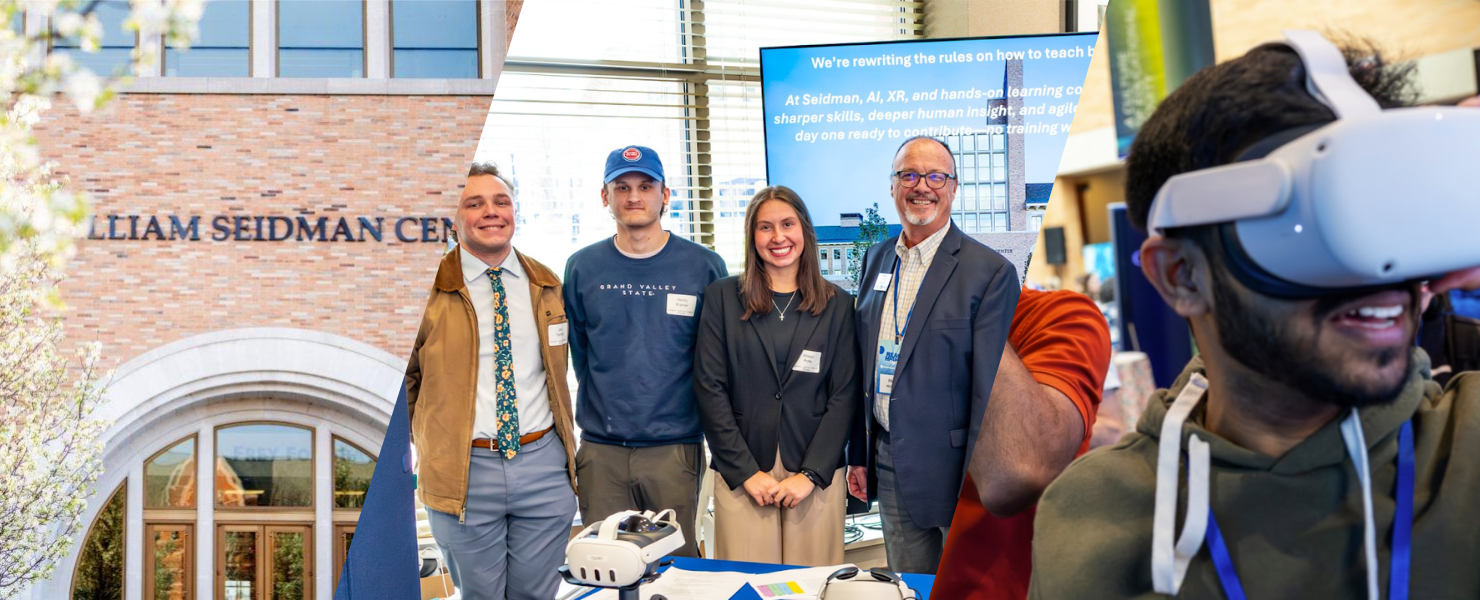From Sandbox to Scale: How Grand Valley State Uses VR + AI to Make Students Workforce‑Ready
See how Prof. Paul Hillman turned a $500 grant into a VR‑powered communication program that’s raising student confidence and employability.

What if every business student could walk into their first job already battle‑tested in tough interviews, ethical standoffs, and boardroom debates?
At the Seidman College of Business at Grand Valley State University (GVSU) in Michigan, Professor Paul Hillman is reshaping how students learn communication and leadership. A former IT consultant turned educator, Hillman integrates a systems-thinking approach into his teaching, blending emerging technologies like virtual reality (VR) and artificial intelligence (AI) with real-world business applications.
The Sandbox Grant That Sparked a Movement
Hillman’s journey began in 2023 with a “sandbox grant”, a low-barrier application that earned him $500 to explore innovative teaching tools. Already owning a headset himself, he encouraged 10 colleagues to apply as well. “Suddenly, we all had Meta Quest 2s,” he recalled. What followed was nearly a year of experimentation: monthly meetups to explore immersive platforms, troubleshoot software, and brainstorm educational applications.
Those early sessions sparked a realization: VR can prepare students for real-world careers in ways textbooks cannot. The challenge then became finding the right VR software platform to deliver on his educational goals.
Why Ovation Stood Out
Having spent years as a software consultant advising Fortune 500 companies, Hillman knew what to look for: scalability, responsive support, and a product that solved a real instructional need. Ovation checked all those boxes and went further by delivering a compelling use case: communication practice enhanced by AI.
Unlike other tools, Ovation offered Scenario Modifiers—custom AI prompts that rewire an avatar’s personality in seconds—which let Hillman tailor AI-powered avatars to match the learning outcomes he wanted to emphasize. From job interviews to team conflict resolution, each simulation could be uniquely adapted to mirror real-world situations and align with what mattered most in his curriculum.
“It wasn’t just about speaking in VR,” he explained. “It was about creating moments where students had to think on their feet, defend their values, and learn from real-time feedback.”
Real Accountability: AI Avatars That Push Back
Hillman’s use of Ovation became especially impactful in his business ethics course. To help students reflect on what drives them, he began with a written assignment. The students first wrote down their personal values, reviewed the company’s values, and then started a job interview scenario in Ovation.
Seated in a virtual lodge with a CEO avatar, the interview begins with deceptively simple questions: “Why are you here? What do you know about our firm?”
The AI listens closely. If students offer superficial answers and can’t name the company’s values, the CEO calls them out. “Did you do any research about our firm before coming in today? There’s really no sense in continuing this interview. You were not prepared.”
This immediate, adaptive dialogue provides an intensity and accountability that students rarely experience in traditional classroom role-play.
Admin Buy-In: One Demo Was All It Took
When Hillman invited Dean Diana Lawson of GVSU’s Seidman School of Business to try the same interview simulation, she was caught off guard. Hillman had purposely not given her any background information on the company, and the CEO avatar relentlessly questioned her.
After completing the exercise, Dean Diana Lawson said, “This is how we must enhance our teaching. The realistic setting, emphasis on soft skills, and built-in student feedback tools make it a powerful way to bring the real world into the classroom. It supports faculty in delivering high-impact learning in a low-risk format. This is exactly the kind of innovation higher ed needs.”

Scaling Across Seidman
With buy-in from the Dean, Hillman secured funding for 14 additional headsets and began building a suite of simulations tailored to various business topics. These weren’t generic one-size-fits-all modules. Using Scenario Modifiers, he worked closely with colleagues to design role-plays specific to their needs:
- Addressing poor team participation
- Navigating workplace conflicts
- Managing ethical dilemmas and employee misconduct
- Applying motivational theories in HR scenarios
Each simulation could be adapted to reflect a faculty member’s unique voice and goals: what Hillman calls their “secret sauce.” Ovation made it easy to encode that voice into the AI behavior of each avatar, making every interaction feel deeply personal and pedagogically relevant.
Measuring Growth with Assignments & Reports
Another key feature driving results at GVSU is Ovation’s Assignment feature. With Assignments, Hillman can design a session on the web, track who completes it, and review detailed AI reports for each student submission.
This streamlined visibility makes participation easier to measure and feedback more actionable. For instructors managing multiple sections and scenarios, Assignments simplify setup and amplify impact.
Hillman had 105+ students complete two assignments in three weeks.
Alumni Impact and Lifelong Learning
Just weeks after graduation, a former student emailed Hillman in a panic. She had to deliver a high-stakes presentation at her new firm in Chicago and didn’t feel ready. Hillman arranged a headset for her and used Ovation’s Multiplayer feature (think Zoom, but inside a 3D virtual conference hall) to rehearse with her remotely.
They practiced together, refined her delivery, and applied the same AI-fueled feedback she’d received in class. As a result, she nailed the presentation.

“We had a major customer presentation scheduled for June—250 to 300 people—and my new boss suddenly couldn’t make it. I immediately thought of Ovation. I’d used it at GVSU in Professor Hillman’s ethics class, so I knew how powerful the multi-user speech delivery feature could be. I reached out to him, and even though he was in Northern Michigan and I was in Chicago, we quickly met inside Ovation’s realistic hotel conference room. He coached me through my first draft, and I practiced several more times on my own over the next few days. By the time the real presentation came, I was confident, calm, and it went incredibly well. Zero nerves.” —Ellie W.
For Hillman, the goal is to give students skills that extend beyond the classroom and into the real world.
Looking Ahead: Ovation as a Platform for the Future
Hillman is only getting started. He imagines a future where students debate economic philosophers, negotiate with virtual executives, and build critical thinking skills through avatar-based Socratic dialogue, all within Ovation.
“Ovation is not just a public speaking app,” he said. “It’s a platform for transformational learning. This is how business education should evolve.”
He continues to work closely with Ovation founder Jeff Marshall to push what’s possible in VR-enhanced education. As Hillman sees it, tools like Ovation are ahead of the curve and shaping the next one. Paul Hillman’s passion for tech-enabled learning extends far beyond the classroom. This summer, he visited the Africa VR Campus and Center near Nairobi, Kenya, where students (many of them young women) are using virtual reality to learn coding, storytelling, and digital design. To support their efforts, Hillman is collecting Meta Quest 2 headsets and donations to help equip the next class with the tools they need to succeed.
A New Standard for Experiential Business Education
At GVSU, students are learning to speak with clarity, think critically, and respond under pressure. They’re entering the workforce more confident and more prepared, because their education didn’t just happen in lectures or textbooks. It happened in lifelike, AI-powered simulations built with intention, supported by data, and personalized for growth.
And it all started with a $500 grant and a professor who believed business education could be (and should be) radically different.
Interested in bringing Ovation to your campus? New organizations can try Ovation free for 30 days. Learn more.

